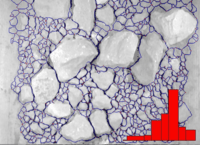Granulometry (morphology)
In mathematical morphology, granulometry is an approach to compute a size distribution of grains in binary images, using a series of morphological opening operations. It was introduced by Georges Matheron in the 1960s, and is the basis for the characterization of the concept of size in mathematical morphology.
| Granulometry | |
|---|---|
 | |
| Basic concepts | |
| Particle size · Grain size Size distribution · Morphology | |
| Methods and techniques | |
| Mesh scale · Optical granulometry Sieve analysis · Soil gradation | |
Related concepts | |
| Granulation · Granular material Mineral dust · Pattern recognition Dynamic light scattering | |
- merge with Optical granulometry
Granulometry generated by a structuring element
Let B be a structuring element in a Euclidean space or grid E, and consider the family , , given by:
- ,
where denotes morphological dilation. By convention, is the set containing only the origin of E, and .
Let X be a set (i.e., a binary image in mathematical morphology), and consider the series of sets , , given by:
- ,
where denotes the morphological opening.
The granulometry function is the cardinality (i.e., area or volume, in continuous Euclidean space, or number of elements, in grids) of the image :
- .
The pattern spectrum or size distribution of X is the collection of sets , , given by:
- .
The parameter k is referred to as size, and the component k of the pattern spectrum provides a rough estimate for the amount of grains of size k in the image X. Peaks of indicate relatively large quantities of grains of the corresponding sizes.
Sieving axioms
The above common method is a particular case of the more general approach derived by Matheron.
The French mathematician was inspired by sieving as a means of characterizing size. In sieving, a granular sample is worked through a series of sieves with decreasing hole sizes. As a consequence, the different grains in the sample are separated according to their sizes.
The operation of passing a sample through a sieve of certain hole size "k" can be mathematically described as an operator that returns the subset of elements in X with sizes that are smaller or equal to k. This family of operators satisfy the following properties:
- Anti-extensivity: Each sieve reduces the amount of grains, i.e., ,
- Increasingness: The result of sieving a subset of a sample is a subset of the sieving of that sample, i.e., ,
- "Stability": The result of passing through two sieves is determined by the sieve with smallest hole size. I.e., .
A granulometry-generating family of operators should satisfy the above three axioms.
In the above case (granulometry generated by a structuring element), .
Another example of granulometry-generating family is when , where is a set of linear structuring elements with different directions.
See also
References
- Random Sets and Integral Geometry, by Georges Matheron, Wiley 1975, ISBN 0-471-57621-2.
- Image Analysis and Mathematical Morphology by Jean Serra, ISBN 0-12-637240-3 (1982)
- Image Segmentation By Local Morphological Granulometries, Dougherty, ER, Kraus, EJ, and Pelz, JB., Geoscience and Remote Sensing Symposium, 1989. IGARSS'89, doi:10.1109/IGARSS.1989.576052 (1989)
- An Introduction to Morphological Image Processing by Edward R. Dougherty, ISBN 0-8194-0845-X (1992)
- Morphological Image Analysis; Principles and Applications by Pierre Soille, ISBN 3-540-65671-5 (1999)